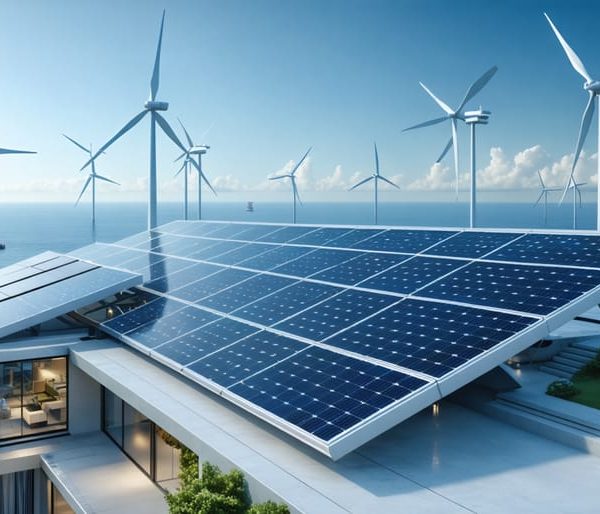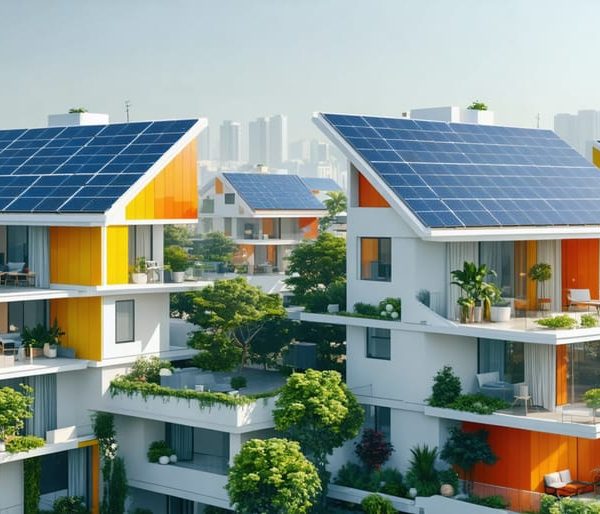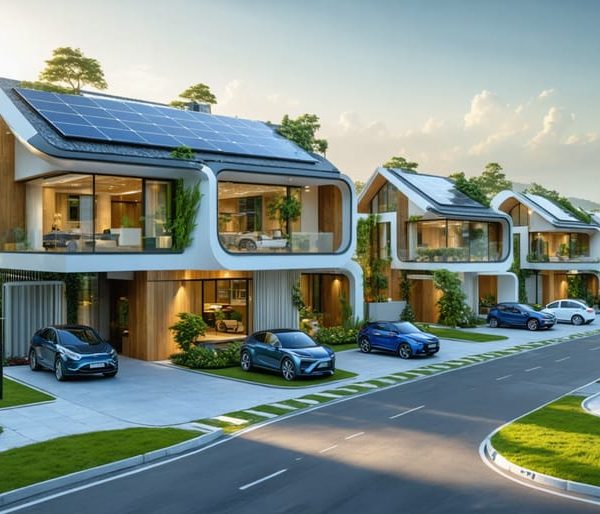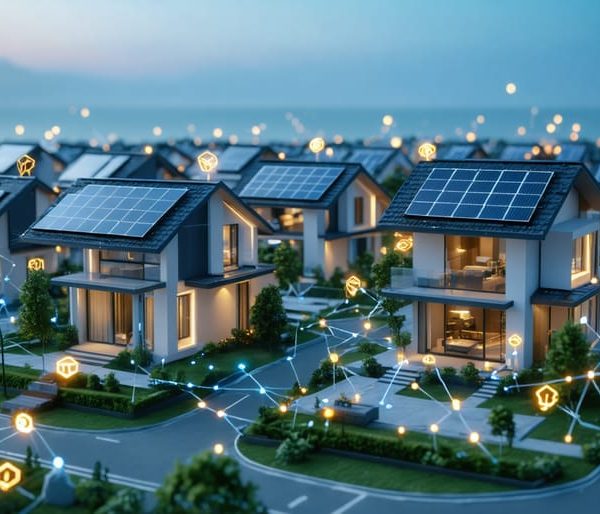These New Solar Materials Are Revolutionizing Home Energy Systems
Revolutionize your property’s energy future with groundbreaking renewable technologies that are transforming how we power our homes and businesses. Today’s integrated solar solutions have evolved far beyond traditional panels, introducing remarkable innovations like perovskite solar cells that achieve 30% higher efficiency and transparent solar windows that generate power while maintaining natural lighting.
These emerging technologies aren’t just theoretical – they’re becoming increasingly accessible to homeowners and property managers. Cutting-edge solar tiles now seamlessly blend with existing architecture, while advanced energy storage systems harness artificial intelligence to optimize power distribution throughout your property. The most exciting part? Installation costs have dropped by 70% over the past decade, making these innovations more affordable than ever.
Whether you’re considering a first-time solar installation or upgrading existing systems, the latest renewable technologies offer unprecedented opportunities to reduce energy costs while contributing to a sustainable future. From self-cleaning solar surfaces that maintain peak efficiency to smart monitoring systems that provide real-time performance data, these advancements are making renewable energy more practical, efficient, and accessible for everyone.
Perovskite Solar Cells: The Game-Changer for Home Solar

Why Perovskites Matter for Your Home
Imagine cutting your energy bills in half while helping the planet – that’s the promise of perovskite solar cells, one of the most exciting solar energy breakthroughs in recent years. These next-generation solar materials are making waves in the renewable energy world, and for good reason.
What makes perovskites special is their remarkable efficiency at converting sunlight into electricity. While traditional silicon solar panels typically convert 15-20% of sunlight into power, perovskite cells have achieved efficiency rates above 25% in laboratory settings. Even better, they’re much cheaper to produce than conventional solar panels.
Think of perovskites as the lightweight champions of solar technology. They can be manufactured using simple, room-temperature processes, unlike traditional solar cells that require energy-intensive high-temperature production. This means lower manufacturing costs, which translates to savings for homeowners like you.
But perhaps the most exciting feature is their versatility. Perovskites can be printed like newspapers, sprayed like paint, or even made into flexible sheets. Imagine solar panels that conform to your roof’s curves or windows that generate electricity while letting in natural light. These possibilities are becoming reality, making it easier than ever to incorporate solar power into your home’s design.
As this technology continues to develop, we’re looking at a future where affordable, efficient solar power isn’t just a dream – it’s a practical solution for every home.
Installation and Maintenance Considerations
Installing perovskite solar technology requires careful consideration of both the physical setup and ongoing maintenance needs. Unlike traditional silicon panels, perovskite installations currently need specialized handling due to their sensitivity to environmental factors. Most installations are best handled by certified professionals who understand the unique properties of these materials.
The installation process typically begins with a thorough site assessment to ensure optimal positioning and structural support. Mounting systems need to be designed specifically for perovskite panels, taking into account their lighter weight and different physical properties compared to conventional solar panels.
For maintenance, regular inspections are essential, ideally every six months. Property owners should look for signs of degradation, such as color changes or reduced power output. While perovskite cells are becoming more durable, they still require protection from extreme weather conditions and moisture exposure.
A monitoring system is crucial for tracking performance and identifying any efficiency drops early. Many modern installations include smart sensors that alert owners to potential issues before they become serious problems.
To maximize longevity, consider these key maintenance points:
– Keep panels clean and free from debris
– Check sealing and encapsulation regularly
– Monitor temperature conditions
– Schedule professional inspections annually
– Keep detailed performance records
With proper care and maintenance, emerging perovskite installations can provide reliable renewable energy while contributing to a more sustainable future.
Transparent Solar Windows: Power from Every Surface
How Transparent Solar Actually Works
Transparent solar technology represents a groundbreaking advancement in renewable energy, turning ordinary windows and glass surfaces into power-generating assets. Unlike traditional solar panels, these innovative materials are nearly invisible to the naked eye while still capturing solar energy. The secret lies in selective light absorption – the technology allows visible light to pass through while capturing ultraviolet and infrared light to generate electricity.
This revolutionary approach opens up countless possibilities for building integrated photovoltaics, transforming skyscrapers, homes, and even car windshields into subtle power plants. The transparent cells are created by applying a thin, organic layer of light-absorbing materials onto glass surfaces, maintaining up to 70% transparency while generating clean energy.
While current efficiency rates hover around 5-10% (compared to traditional solar panels at 15-20%), the technology’s ability to utilize previously unused surfaces makes it a game-changing addition to the renewable energy landscape. Imagine office buildings that power themselves through their windows or greenhouse structures that generate electricity while still allowing plants to thrive underneath. This versatility makes transparent solar a promising solution for urban environments where space for conventional solar panels is limited.

Real-World Performance and Cost Benefits
Recent case studies show that emerging renewable technologies are delivering impressive returns on investment for both homeowners and businesses. For example, new-generation solar panels with enhanced efficiency are producing up to 30% more energy than traditional panels, leading to faster payback periods – typically within 4-6 years instead of the previous 8-10 years.
A medium-sized business in California reported a 45% reduction in their annual energy costs after installing smart solar tracking systems combined with advanced storage solutions. Homeowners using hybrid solar-thermal systems have seen their heating bills drop by up to 70% while reducing their carbon footprint by an average of 4 tons per year.
The durability of newer materials also means lower maintenance costs. Modern solar installations are lasting 25-30 years with minimal degradation, compared to earlier versions that showed significant efficiency loss after 15 years. This extended lifespan, combined with decreasing installation costs, has brought the levelized cost of solar energy down to 6-8 cents per kilowatt-hour in many regions.
Additionally, smart monitoring systems now allow users to track performance in real-time, optimizing energy usage and maximizing financial benefits. Many users report achieving complete energy independence during peak summer months, effectively eliminating their electricity bills during these periods.
Bifacial Solar Panels: Double the Energy Collection
Maximizing Your Roof’s Solar Potential
Getting the most from your solar installation starts with smart positioning and careful planning. The key to maximizing solar potential lies in understanding your roof’s unique characteristics and making informed decisions about panel placement.
First, evaluate your roof’s orientation. South-facing surfaces typically receive the most sunlight in the Northern Hemisphere, making them ideal for panel installation. However, east and west-facing sections can also be viable options, especially with modern high-efficiency panels.
Consider your roof’s pitch angle – the sweet spot usually falls between 30-45 degrees. If your roof’s angle isn’t optimal, mounting brackets can help achieve the perfect tilt. Remember to account for potential shade from nearby trees, buildings, or other structures that might affect panel performance throughout the day.
To optimize your setup, invest in microinverters or power optimizers. These devices ensure each panel operates at peak efficiency independently, preventing a single shaded panel from reducing the entire system’s output. Smart monitoring systems can help track performance and identify any issues before they impact your energy production.
Regular maintenance is crucial. Keep panels clean and free from debris, and trim back any encroaching vegetation. Consider installing snow guards in colder climates to prevent snow accumulation from sliding off panels and potentially damaging them.
For maximum efficiency, work with a certified solar installer who can create a custom layout based on your specific roof configuration and local climate conditions. They can help determine the optimal number of panels and their precise positioning to achieve the best possible return on your investment.
Cost vs. Traditional Panels
When comparing emerging solar technologies with traditional panels, the initial investment might seem higher at first glance. However, these innovative solutions can reduce energy costs significantly more over time, typically offering a 20-30% better return on investment compared to conventional panels.
The average payback period for traditional solar panels ranges from 5-7 years, while newer technologies can achieve breakeven in just 3-5 years, thanks to their superior efficiency rates. For a typical 2,000-square-foot home, traditional panels might cost $15,000-$20,000, while advanced solutions could range from $18,000-$25,000 before incentives.
What makes the higher upfront cost worthwhile? These emerging technologies often require less roof space, generate more power in low-light conditions, and maintain higher efficiency rates in varying weather conditions. Additionally, many come with smart monitoring systems and longer warranties, adding value to your investment.
Factor in federal tax credits, state incentives, and increased property values, and the cost difference becomes even more appealing. Many homeowners report monthly energy savings of 60-80% with newer technologies, compared to 40-60% with traditional panels. When considering long-term value, emerging solar technologies often prove to be the more economical choice despite their higher initial price tag.
Solar Skin Design: Aesthetics Meets Efficiency

Maintaining Your Home’s Look While Going Solar
Gone are the days when solar panels meant compromising your home’s curb appeal. Modern solar solutions offer numerous design options that seamlessly integrate with your home’s architecture while maximizing energy efficiency. Solar roof tiles, which mimic traditional shingles, have revolutionized how we think about residential solar installations. These tiles come in various colors and styles, making it possible to maintain your home’s aesthetic while embracing renewable energy.
For those preferring traditional panels, manufacturers now offer sleek, low-profile designs in different colors, including all-black options that blend naturally with dark roofing materials. Custom mounting systems can adjust panel angles and positioning to minimize visual impact while optimizing sun exposure.
Creative screening options like decorative borders or strategic landscaping can help integrate solar installations into your overall property design. Some homeowners incorporate solar panels into pergolas or carports, turning functional spaces into energy-generating features.
Building-integrated photovoltaics (BIPV) represent another innovative solution, incorporating solar technology directly into building materials like windows and facade elements. These systems generate power while serving as architectural elements, eliminating the need for visible external panels.
Many local solar installers now offer 3D modeling services, allowing you to visualize different panel layouts and designs before installation. This technology helps homeowners make informed decisions about panel placement and configuration, ensuring satisfaction with both performance and aesthetics.
Remember, a well-designed solar installation can actually increase your property’s value while maintaining its visual appeal.
Performance Impact of Solar Skins
The integration of solar skins into traditional solar panels does affect their overall performance, though recent technological advances have minimized this impact significantly. On average, solar skins reduce energy production by about 10-15% compared to traditional panels. However, this slight decrease in efficiency is often outweighed by the aesthetic benefits and increased adoption rates.
Modern solar skin technology uses advanced photovoltaic materials that allow most sunlight to pass through while displaying custom designs. For a typical 6kW residential system, this might translate to a reduction of 600-900kWh in annual energy production. However, manufacturers have been making steady improvements, with newer generations showing only 5-8% efficiency loss.
Real-world testing has shown encouraging results. For instance, homeowners in suburban areas report that their solar skin installations still produce more than enough power to meet their daily needs. The key lies in proper system sizing – by slightly increasing the total panel area, installers can compensate for any efficiency reduction while maintaining desired energy output.
Temperature management is another crucial factor. Solar skins can actually help regulate panel temperature in some cases, potentially improving performance during hot summer months. This thermal regulation partially offsets the initial efficiency loss, especially in warmer climates where traditional panels might suffer from heat-related performance degradation.
The bottom line? While solar skins do impact performance, careful system design and installation can ensure your solar investment still delivers excellent returns while looking aesthetically pleasing.
As we’ve explored the exciting world of emerging renewable technologies, it’s clear that the future of sustainable energy is brighter than ever. These innovations are not just reshaping how we harness solar power but are making renewable energy more accessible and efficient for homeowners like you.
From transparent solar panels that transform windows into power generators to advanced battery storage systems that maximize energy efficiency, these technologies are revolutionizing home energy solutions. The best part? Many of these innovations are becoming increasingly affordable and easier to implement.
For homeowners ready to embrace these technologies, the path forward is clear. Start by assessing your property’s energy needs and solar potential. Consider consulting with local renewable energy experts who can help you understand which emerging technologies best suit your specific situation. Many utility companies now offer energy audits and can connect you with certified installers.
Remember, you don’t have to implement everything at once. Begin with foundational technologies like traditional solar panels or smart energy management systems, then gradually incorporate newer innovations as they become more established in the market. Take advantage of available tax incentives and rebates, which can significantly reduce your initial investment.
By staying informed about these emerging technologies and making strategic investments in renewable energy, you’re not just reducing your carbon footprint – you’re becoming part of the sustainable energy revolution that will shape our future.











